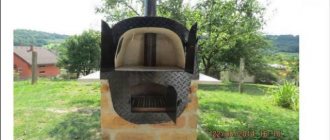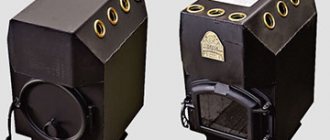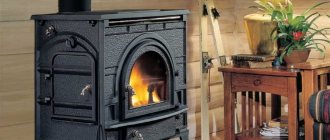The convenient potbelly stove has been known since the 18th century and still continues to be a more profitable alternative to expensive fireplaces and large stoves. The device gained wide popularity due to its trouble-free operation and simple design; it could be easily made independently, but the main disadvantage of such stoves was their high fuel consumption. Modern potbelly stoves are most often installed in bathhouses, cottages or apartments as a decorative element, while their use for their intended purpose is quite economical and does not cause problems.
Principle of operation
Diagram of a potbelly stove
The potbelly stove is a compact device suitable for heating small rooms. With its help, you can quickly heat a room and maintain it at an optimal temperature for a long period. Such a stove does not require additional equipment; it is easily transported from one place to another, unless we are talking about a potbelly stove made of brickwork for a summer residence, and is installed without much effort.
It is not so difficult to assemble a potbelly stove yourself, for example, from bricks, barrels or old cylinders. In addition to the main structural elements, it can be supplemented with a heat exchanger, with which it will work much more efficiently. This part ensures long-lasting combustion and the necessary heat transfer when using any fuel. In order for the device to function correctly, it is worth preparing its drawing in advance, where all the details will be taken into account. A standard potbelly stove consists of the following elements:
- long burning chamber;
- ash pan;
- pipe outlet for a standard chimney;
- legs and frame;
- door with a latch.
In equipment of this type, as in other stoves, there must be a chimney with a door to maintain combustion at the required level and comply with safety standards.
Main functions
Today, such models have a variety of styles. When installing them for heating, they also serve as room decoration.
The fuel for such a system is firewood, the length of which does not exceed 25 cm. You can also use other solid fuels. The main purpose of the potbelly stove:
- heating the building;
- cooking;
- interior detail or decorative decoration.
"Burzhuyka" successfully competes with brick and fireplace systems. However, it has one very important advantage: its dimensions are not large. This stove is easy to transport and connect. It is often used outdoors for cooking on a picnic.
When you constantly have to transport the stove to different places, a collapsible design may be the optimal solution. The top cover, which acts as a hob, is removed. The legs are very easy to disassemble and the chimney to be removed. If desired, you can divide the entire stove into several separate sections.
As a result, you don’t need a lot of space to store the stove; it becomes mobile and easy to transport.
Using such a heating device, you don’t have to worry about carbon monoxide getting into the upper respiratory tract. All harmful gas is removed through the chimney. To achieve this effect, it is very important to carry out the correct installation. The stove's power will reach its maximum if good draft is created.
Varieties of potbelly stoves
Potbelly stove with hob
The military stove is presented in several versions and is divided into categories depending on the purpose, materials and type. According to their purpose, such devices are divided into heating options intended for heating rooms, and stoves with cooking surfaces. The material used for their manufacture is cast iron or metal. Cast iron devices have a low level of thermal conductivity, but at the same time they are able to retain heat indoors for as long as possible.
Due to the large weight of cast iron, transporting such stoves is problematic, so they are installed in one place for a long time. Metal options with special screens quickly heat rooms, but release heat faster due to its accelerated release. It is best to purchase metal potbelly stoves, complemented by external sheets of metal, which will allow the device to remain hot for a long time even after being turned off. If desired, the stove can be additionally decorated with brick, tiles and other materials.
Classical
A classic potbelly stove is characterized by: low efficiency, rapid combustion of fuel combined with long-term heat retention.
Depending on the duration of combustion, stoves are also divided into two types. The classic version is characterized by low efficiency, rapid fuel combustion combined with long heat retention. The special design of the device is made so that the heat intensity depends on the flow of incoming air. You can install a stove of this type in your home or country house, taking into account the requirements for its installation.
Long burning
Iron wood stoves of this type are more expensive. They have a single-chamber design and require a rare supply of fuel, since in long-burning devices it is consumed more slowly. Such stoves are more difficult to light; air is supplied inside in doses; fuel is not added until the previous portion has burned out. They also have their advantages, including good efficiency, high levels of efficiency and low fuel consumption.
Price
Affordable price is one of the most attractive aspects of potbelly stoves.
For example, a small 5 kW Hephaestus cast iron stove will cost about 3.5 thousand rubles. Similar stoves with higher power, with a deck, burner and other additions can cost 5 - 8 thousand rubles.
A separate row of stoves, which are not so much a heating device as a highlight of the interior.
Their walls and doors are decorated with solid patterns and monograms. The cost of such works varies greatly, but on average it is 10 – 14 thousand rubles.
Let's summarize. The potbelly stove does not shine in many respects. But if you need to heat a small house, spending a minimum of money, then the optimal solution would be to install a potbelly stove with the construction of a brick casing.
The disadvantage of potbelly stoves is that they have a short burning time, so long-burning wood-burning stoves for summer cottages are most preferable, especially for those who like to turn on the device and forget about it.
Read more about the advantages of solid fuel boilers with a water circuit.
What are stoves suitable for?
A potbelly stove is an excellent solution for a summer residence.
Thanks to its primitive and simple design, a potbelly stove-fireplace or a standard stove is suitable for any room that needs full heating. It can be installed in a country house, in a bathhouse, in a private or country house. Manufacturers offer a fairly extensive range of such stoves, among which you can find stylish options that can fit favorably into the interior. A potbelly fireplace designed for a country house will come in very handy during the cold season.
Inexpensive options with a chimney or an arm will be a real boon for owners of dachas and private buildings where gas cannot be piped. Modern stoves are much better than Soviet RF stoves in terms of heat retention; large devices can also be used to heat rooms with an impressive area. The market also offers quite expensive options of various sizes with excellent design and an increased level of fire safety, including sauna or wood-burning stoves.
When choosing a device, it is important to determine in advance for what purposes it will be used, since modern potbelly stoves are suitable not only for heating. They can be used for cooking or as a decorative element.
Steel furnaces: advantages
- One of the first and most compelling arguments in favor of steel stoves is cost. It is quite affordable, but is growing rapidly not only with the popularity of the brand, but also with the replacement of steel with higher quality and appropriate heat-resistant steel, as well as with an increase in wall thickness. The price additionally changes if you select a stove with improved decorative properties and increased versatility;
- Large assortment on the market - selection and purchase are greatly simplified;
- Several types of main fuel, which allows you to heat the stove not only with ordinary firewood, but also with wood briquettes;
- Good heat dissipation, the ability to quickly heat up and transfer heat into the room;
- Compact size and modern design, overall positive appearance;
- Improved quality and increased durability of heat-resistant furnaces due to the material’s resistance to temperature changes;
- Quite simple installation due to standardization of design and low weight of the heating device;
- Resistance of the structure to mechanical damage;
- Additional features of more expensive steel stove models, for example, heating + cooking;
- A wide range of power for choosing a stove in the case of equipping not only a small veranda, but also a more spacious living room at home!
Pros and cons of potbelly stoves
Most designs are light in weight and do not require special care.
Modern potbelly stoves have many more advantages compared to devices that were popular during the Soviet era. They are compact in size, do not cause difficulties during operation, can be combined with various types of fuel, and at the same time are quite economical compared to gas heating appliances. Most structures do not weigh much, so they are easy to transport if necessary. They are also easy to install; this process will be accessible even to a beginner who is familiar with safety rules.
A practical Armavir or water stove of this type heats up quickly and at the same time consumes fuel as economically and efficiently as possible, continuously heating the room for 6-10 hours. Cast iron and metal models for a home or garage are durable and do not require special care, and most stoves do not require the installation of a permanent chimney or a special pipe.
Furnaces of this type also have their disadvantages, for example, lack of autonomy and the presence of a fire risk, which can be minimized if you monitor the device. During operation, it is better not to touch the oven body to avoid burns, since it always gets very hot.
Safety Recommendations
- The ash drawer can only be cleaned when the stove has completely cooled down. Simply remove it and throw away the contents (remember that the ash can remain hot for several hours).
- It is better to use dry wood for ignition. The volume of the filling is no more than ¼ of the volume of the entire firebox.
- Do not store flammable liquids, objects, or rags near the stove body.
- Hot walls can cause burns - handle the stove carefully and do not leave it unattended for a long time, especially if children are nearby!
- It is better to store fuel away from the stove, and not under it (the temptation is great if the model has legs). This will protect the firewood from sparks hitting it and, as a result, fire.
- The firebox door must not be opened during combustion (except for short moments when you need to work with a poker and immediately close the door).
- By the way, in factory models of potbelly stoves it is taken into account that the door must close very tightly. Most models are equipped with a sealing cord and a high-quality lock.
How to make it yourself
Assembled stove
The easiest way to make a potbelly stove yourself is from two metal barrels according to the standard scheme. For this purpose, you will need two barrels, one of which should be smaller. The upper part is cut off from each, and metal handles and locking parts are attached to the remaining part. Before starting work, it is better to rinse the barrels thoroughly to get rid of any unpleasant odor that might remain there. Assembling such a stove according to the rules consists of several stages, performed step by step:
- A rectangle with an area of 25x10 cm is cut out at the bottom of a large barrel; this compartment will become a compartment for a drawer.
- You need to attach two guides measuring 2.5x2.5 cm to the bottom.
- A tray is cut out of a metal sheet along a contour no more than 1-2 cm thick, which will become the basis for the chamber and can isolate it from the ash pan.
- A hole with a diameter of 6 cm is cut out in the central part of the pallet and the bottom of a small barrel, after which the pallet is welded at a distance of at least 15 cm from the bottom of the container.
- At the final stage, a hole is made in the body of the large barrel required for the flue pipe and a convenient damper with a small handle is built into the pipe.
- A small barrel is placed inside a large one so that each hole in them coincides.
To add fuel, make a cone at least 1.5 meters long, which is made of metal or wood. The bottom of such a cone should pass freely through the hole in the pan.
Material options
Drawing of a wood-burning potbelly stove.
Basically, potbelly stoves are made from metal barrels or gas cylinders, using additional materials and equipment for this purpose. To make a full-fledged device, it is advisable to first prepare a drawing of the future potbelly stove, brick or cast iron, and stock up on all the necessary materials. The drawing indicates in advance the main and auxiliary parts, for example, a heat exchanger. Stoves from a barrel and a cylinder are assembled according to a similar scheme, following all stages.
A more acceptable option is to build a brick stove; a device of this type has more advantages: it cools slowly and retains heat longer. Also, brick potbelly stoves look quite neat in any room. For a collapsible or conventional stove of this type, there are two construction options; you can build it yourself using bricks according to a standard scheme, or you can line a finished potbelly stove made of metal with bricks. The choice of option depends on the situation and the amount of free time.
Fireproof decor on the floor
The potbelly stove can be installed directly on the floor if it is made of porcelain stoneware or tiles. But if the floor covering is flammable (parquet, boards, carpet, linoleum), it must be partially removed and provided with a thick layer of fire-retardant material.
You can make a podium using a brick, on top of which you should lay a cement screed. It is recommended to place a metal sheet under the combustion door.
What kind of chimney is needed?
Chimney for a potbelly stove
Without a chimney, it will be impossible to use a potbelly stove, so you should take care of the manufacture of this part in advance. To make a pipeline, you can purchase ready-made pipes or make them yourself from sheet metal. The second option will be cheaper. During the assembly process, a smoke channel is assembled from pipes and a corner element, which is then welded to the finished potbelly stove.
The material used for the chimney is brick, steel or other metal pipes, ceramics, vermiculite or asbestos cement. You should choose the appropriate option based on your budget and installation complexity.
Sometimes chimney pipes are made of special heat-resistant glass, but working with this material requires special skill. Glass chimneys are also not very practical.
The optimal choice for beginners will be ready-made stainless steel pipes; their main advantages are: light weight, reasonable price and lack of difficulties at all stages of assembly.
In minimalism
For those who like simplicity, a compact cast-iron fireplace without frills is suitable. Simple shapes fit perfectly into the surrounding environment. Minimalism is distinguished by a calm color scheme in natural tones, monochrome elements and a rejection of unnecessary decor.
The potbelly stove will be the detail that will give the room character.
History of origin
The potbelly stove came to us from the 19th century. History remembers this period with devastation and poverty. In those days, only in rural areas there were no problems with heating houses. And in cities, only wealthy people could heat their apartments.
The stove got its name, which is comparative to the bourgeoisie, due to its high fuel consumption and low heat output. The walls, made of metal, had no thermal capacity and maintained the temperature only during the combustion process.
In eclecticism
This direction combines several elements of different styles. It most fully meets the main principle of interior design, as it strives to reflect the character of a person.
Give preference to a simple design so that the potbelly stove does not overload the space, or choose an unusual model to make it the main decoration of the room.
Device
The construction of a potbelly stove is quite simple. It is a rectangular metal box on support legs, equipped with:
- a firebox with a door into which firewood is placed;
- ash pan, which must be systematically cleaned;
- an all-metal chimney pipe (length 5 meters or more: the draft force depends on this parameter).
The main fuel for a potbelly stove is wood.
The furnace operates as follows: the heated flow first passes through the chimney pipe shifted to the side, and then only rushes beyond its limits. The fuel burns, the stove heats up, and the heat is transferred to the room in which it is installed.
The ash enters the ash pan through a special mesh, so the volume of the furnace working area does not decrease.











